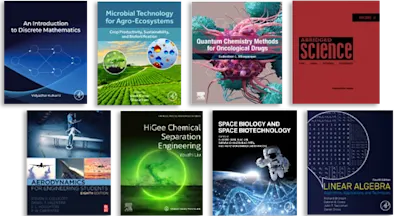
Artificial Intelligence and Multimodal Signal Processing in Human-Machine Interaction
- 1st Edition - September 24, 2024
- Latest edition
- Editors: Abdulhamit Subasi, Saeed Mian Qaisar, Humaira Nisar
- Language: English
Artificial Intelligence and Multimodal Signal Processing in Human-Machine Interaction presents an overview of an emerging field that is concerned with exploiting multiple modali… Read more

Readers are introduced to the multimodal signals and their role in the identification of the intended subjects, mental state and the realization of HMI systems are explored, and the applications of signal processing and machine/ensemble/deep learning for HMIs are assessed. A description of proposed methodologies is provided, and related works are also presented. This is a valuable resource for researchers, health professionals, postgraduate students, post doc researchers and faculty members in the fields of HMIs, Brain-Computer Interface (BCI), Prosthesis, Computer vision, and Mental state estimation, and all those who wish to broaden their knowledge in the allied field.
- Covers advances in the multimodal signal processing and artificial intelligence assistive HMIs
- Presents theories, algorithms, realizations, applications, approaches, and challenges that will have their impact and contribution in the design and development of modern and effective HMI (Human Machine Interaction) system
- Presents different aspects of the multimodal signals, from the sensing to analysis using hardware/software, and making use of machine/ensemble/deep learning in the intended problem-solving
SYED SAAD AHMED, HUMAIRA NISAR, AND LO PO KIM
2. Artificial intelligence techniques for human-machine interaction
HAMID MUKHTAR
3. Feature extraction techniques for human-computer interaction
ABDULHAMIT SUBASI AND SAEED MIAN QAISAR
4. An overview of techniques and best practices to create intuitive and user-friendly human-machine interfaces
VEERENDRA DAKULAGI, KIM HO YEAP, HUMAIRA NISAR, ROHINI DAKULAGI, G N BASAVARAJ, AND MIGUEL VILLAGOMEZ GALINDO
5. An overview of EEG-based human-computer interface (HCI)
MD MAHMUDUL HASAN, SITI ARMIZA MOHD ARIS, AND NORIZAM SULAIMAN
6. Speech-driven human-machine interaction using Mel-frequency Cepstral coefficients with machine learning and Cymatics
SAEED MIAN QAISAR
7. EEG-based brain-computer interface using wavelet packet decomposition and ensemble classifiers
ABDULHAMIT SUBASI AND SAEED MIAN QAISAR
8. Understanding dyslexia and the potential of AI in detecting neurocognitive impairment in dyslexia
SITI ATIYAH ALI, HUMAIRA NISAR, NURFAIZATUL AISYAH AB AZIZ, NOR ASYIKIN FADZIL, NUR SAIDA MOHAMAD ZABER, AND LUTHFFI IDZHAR ISMAIL
9. Early dementia detection and severity classification with deep SqueezeNet convolutional neural network using EEG images
NOOR KAMAL AL-QAZZAZ, SAWAL HAMID BIN MOHD ALI, AND SITI ANOM AHMAD
10. EEG-based stress identification using oscillatory mode decomposition and artificial neural network
SARIKA KHANDELWAL, NILIMA SALANKAR, AND SAEED MIAN QAISAR
11. EEG signal processing with deep learning for alcoholism detection
HAMID MUKHTAR
12. Machine learning and signal processing for ECG-based emotion recognition
FADIME TOKMAK, AYSE KOSAL BULBUL, SAEED MIAN QAISAR, AND ABDULHAMIT SUBASI
13. EOG-based human-machine interaction using artificial intelligence
ALBERTO LOPEZ AND FRANCISCO FERRERO
14. Surface EMG-based gesture recognition using wavelet transform and ensemble learning
ABDULHAMIT SUBASI AND SAEED MIAN QAISAR
15. EEG-based secure authentication mechanism using discrete wavelet transform and ensemble machine learning methods
ABDULHAMIT SUBASI, SAEED MIAN QAISAR, AND AKILA SARIRETE
16. EEG-based emotion recognition using AR burg and ensemble machine learning models
ABDULHAMIT SUBASI AND SAEED MIAN QAISAR
17. Immersive virtual reality and augmented reality in human-machine interaction
MUSTAFA CAN GURSESLI, ANTONIO LANATA, ANDREA GUAZZINI, AND RUCK THAWONMAS
18. Mental workload levels of multiple sclerosis patients in the virtual reality environment
SEDA SASMAZ KARACAN AND HAMDI MELIH SARAOGLU
19. Vision-based action recognition for the human-machine interaction
ANKUSH VERMA, VANDANA SINGH, AMIT PRATAP SINGH CHOUHAN, ABHISHEK, AND ANJALI RAWAT
20. Security and privacy in human-machine interaction for healthcare sector
ANKUSH VERMA, AMIT PRATAP SINGH CHOUHAN, VANDANA SINGH, LEKHA SINGH, GAUTAM SUKLABAIDYA, ABHISHEK SHARMA, AND PANKAJ VERMA
- Edition: 1
- Latest edition
- Published: September 24, 2024
- Language: English
AS
Abdulhamit Subasi
Abdulhamit Subasi is a highly specialized expert in the fields of Artificial Intelligence, Machine Learning, and Biomedical Signal and Image Processing. His extensive expertise in applying machine learning across diverse domains is evident in his numerous contributions, including the authorship of multiple book chapters, as well as the publication of a substantial body of research in esteemed journals and conferences. His career has spanned various prestigious institutions, including the Georgia Institute of Technology in Georgia, USA, where he served as a dedicated researcher. In recognition of his outstanding research contributions, Subasi received the prestigious Queen Effat Award for Excellence in Research in May 2018. His academic journey includes a tenure as a Professor of computer science at Effat University in Jeddah, Saudi Arabia, from 2015 to 2020. Since 2020, he has assumed the role of Professor of medical physics at the Faculty of Medicine, University of Turku in Turku, Finland
SQ
Saeed Mian Qaisar
HN